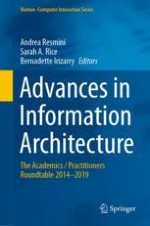This volume reveals the history of Information Architecture (IA), reflects on the relationship between practice and research within the discipline, and presents educators with the latest models, frameworks and theories that have emerged from the Information Architecture Academics and Practitioners Roundtable between 2014 and 2019. The most comprehensive and up-to-date overview of Information Architecture so far, this collection is a valuable tool for teachers, researchers, and practitioners interested in recent advances in information architecture in areas such as pervasive computing and embodiment, artificial intelligence, design practice, diversity and ethics in design, and critique.
The information landscape has grown more complex, porous and connected–the information challenges of smart phones, sensors and IoT demand focused attention from organizations that often embrace a ‘move fast and break things’ ethos.
This book not only explores the shift from Classical IA to Contemporary IA–it asks, are today’s creators prepared to solve the challenges ahead? Have industry-led disciplines abdicated their responsibility to the people who inhabit current information environments? Will this discipline persist?
Advances in Information Architecture examines the maturity of the field, revisits the discipline’s efforts to transform itself in 2013 with the publication of "Reframing Information Architecture", and considers the opportunities that remain to bridge the academic and practitioner communities.
